Abstract
Neom is expected to face climate and environmental challenges, including the provision of water and the mitigation of flood and drought risks. The field data for identifying the potential risk zones are limited. I utilized remote sensing data and geographic information system (GIS) techniques to identify such zones. The datasets used here included drainage density, lineament density, precipitation, elevation, lithology, slope, soil, and land use/land cover. These data were analyzed using a weighted overlay analysis in a GIS environment. The analysis successfully mapped the potential groundwater, flood, and drought zones in Neom. The zone with a good potential for groundwater covered 515 km2 of Neom, whereas 11,562, 10,616, and 289 km2 of land had a moderate, poor, and very poor chance of having groundwater, respectively. The area with the lowest flood danger covered only 195 km2, whereas the areas with a low, moderate, and high flooding risk covered 4355, 13,542, and 4910 km2 of land, respectively. The results of the overlay analysis showed that low and very low drought risks were associated with 4322 and 44 km2 of land, respectively. In turn, 10,615 and 8266 km2 of the region were at a moderate and high drought risk, respectively.
1. Introduction
The Saudi economy has undergone tremendous growth during the modern era of this country, mostly through the exploitation of its natural resources, primarily oil. This growth has provided the country with a solid economic base, which has been supported by rising international oil prices. The leaders of Saudi Arabia are aiming to diversify the economy by supporting non-oil sectors that can contribute more to the country’s gross domestic product (GDP).
As part of this economic diversification, the Kingdom of Saudi Arabia launched Saudi Vision 2030, which will support giant investment initiatives, including the establishment of Neom, a new smart city. This city will occupy a new area and will be built from scratch on empty land. Neom will be located in the northwest of Saudi Arabia and will be one of the greatest construction projects ever undertaken in the Middle East. Planners expect that this city will make Saudi Arabia one of the world’s most popular tourist destinations [1]. Because of its strategic location, this city is projected to host up to 9 million people.
Megaprojects typically involve various risks and obstacles that can lead to project failure. For a city, the risks that are required to be considered include the area’s water supply and its susceptibility to flooding and drought. Ostensibly, Neom will feature a smart infrastructure that will operate on renewable energy, including buildings, transportation, and parks. Moreover, the city must be able to deal with important environmental challenges, such as new water sources for its population and the means to prevent flooding and drought.
Neom will adopt water-collection techniques, such as seawater desalination; however, several critical challenges remain, including high water demand, a lack of reliable renewable water sources, and identifying groundwater resources in an arid location [2]. Overcoming these challenges will be expensive, environmentally unfriendly, and consume a large amount of the country’s energy. Therefore, a natural water source, such as groundwater, is essential to achieve the aims of the smart city [3].
Unexpected floods are an additional environmental concern for this enormous construction project. Despite its arid environment and low annual precipitation, the western coast of Saudi Arabia has undergone numerous surprise floods, the worst of which caused severe damage to communities inhabiting Jeddah city along the Red Sea in 2009 and 2011 [4]. Both natural and human factors contributed to these floods. For example, building houses in close proximity to wadis has resulted in a significant loss of life and property. Furthermore, Saudi Arabia is prone to drought, particularly during the dry season (from June to September). On average, droughts last 7 months, whereas severe droughts can last for about 6 months [5,6,7]. Droughts influence the distribution of precipitation and cause flash floods to occur. These floods will transfer contaminants resulting from industrial, urban, and agricultural activities, such as heavy metals, chlorine, nitrates, and bacteria. During flood flow, these contaminants will percolate into the groundwater to degrade its quality and harm the health of groundwater users [8,9]. The planned location of Neom is near the Red Sea, which is prone to both flooding and drought.
Remote locations such as that where Neom will be built support only a few small communities and populations; thus, inadequate hydrogeological field data are available in these areas to map the potential groundwater, flood, and drought zones. However, using remote sensing data and geographic information system (GIS) techniques, it is now relatively simple and inexpensive to map these areas. Remote sensing data are used to discover geographical features and climate parameters, whereas GIS techniques process and evaluate these data [10,11,12,13].
The aim of the present investigation was to use GIS and remote sensing data to map groundwater in shallow aquifers in Neom along the northeastern coast of the Red Sea, and to identify any areas that may be prone to flooding and drought. Several datasets are necessary to characterize the geographic and climatic properties required to accomplish this objective. These datasets include drainage density, lineament density, precipitation, elevation, lithology, slope, soil, and land use/land cover (LULC). This study may serve as a scientific guide for future planning, particularly for identifying potential natural water supplies in Neom. In addition, the results will help guide policymakers regarding the locations of areas in Neom that will face floods and droughts. Buildings and other structures can be constructed in these areas to mitigate these risks.
2. Materials and Methods
2.1. Study Area
The research site, Neom, has the following coordinates: 27°19′–29°20′ N and 34°29′–36°39′ E (Figure 1). Near the coast, Neom has an elevation of 5 m below the mean sea level, whereas in the mountains, its elevation rises to 2518 m above the mean sea level. The area is situated in the northern part of the east coast of the Red Sea, across from the Gulf of Aqaba. The planned city of Neom covers a total area of 22,617 km2, extending for approximately 285 km along the coast of the Red Sea and the Gulf of Aqaba. One of Neom’s advantages is its central location between three continents, meaning that a large number of the world’s population will be able to reach Neom within 8 h or less.
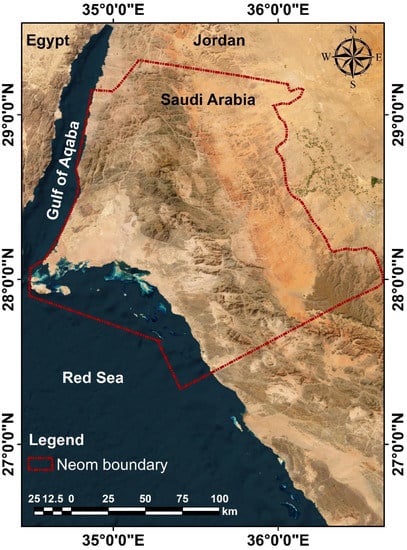
Figure 1.
Map displaying the borders of Neom, which covers 22,617 km2 along the east coast of the Red Sea and the Gulf of Aqaba.
2.2. Geology of the Study Area
The Neom region is located in the Arabian Shield, east of the Red Sea rift on the Midyan Peninsula [14]. The Red Sea, Gulf of Suez, and the Gulf of Aqaba fault system significantly affect the geology of the region. Offshore of Neom lies a major faulted block that trends northwest to southeast [15]. The area is covered by sediments from the Tertiary and Quaternary periods (Figure 2). The floor of the Red Sea comprises a thin sea plain, with a consistent width of 5–10 km, and with deposits with a thickness of 2.0–5.0 m [16]. Alluvial deposits, such as silt, loose sand, gravel, mud, and coralline reef terraces, extend over many meters and are characteristic of the lowest zones and stem mainly from marine Tertiary and Quaternary deposits. The mountains of the Neom region comprise Precambrian igneous and metamorphic rocks, such as andesite, basalt, granodiorite, gabbro, granite, amphibolite, mica schist, and metamorphosed siltstone [17].
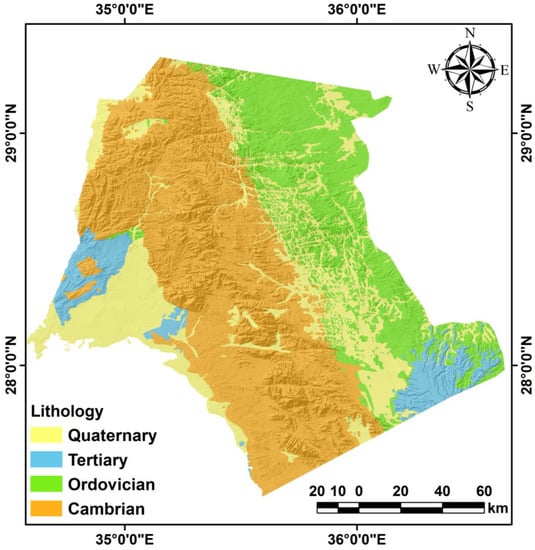
Figure 2.
Map showing the main types of rocks in Neom, which are igneous and metamorphic rocks from the Precambrian period, as well as sedimentary rocks from the Tertiary and Quaternary periods.
2.3. Topography and Hydrology
A topographic map of this research was constructed using a digital elevation model (DEM) representing the Earth’s topographic surface, excluding trees, buildings, and other surface features. At a spatial resolution of the SRTM DEM 30 m (N27E035, N27E036, N28E034, N28E035, N28E036, N29E034, N29E035, N29E036; Figure 3), the elevation of the Neom region ranges from −20 to 2530 m above the mean sea level (AMSL). In the west, the Neom region is characterized by a flat coastal plain with an elevation ranging from −5 to 350 m AMSL. The Red Sea Hills are a mountain range that rises to an elevation of 2518 m AMSL in the region’s center, from north to east. As in many other regions of Saudi Arabia, the climate is that of a continental desert, with large diurnal and seasonal temperature fluctuations. Rain typically falls in the winter season in Neom, which receives 51 and 150 mL of precipitation at the coast and at the Red Sea Hills, respectively. Precipitation in the mountains is dispersed throughout the valleys. The region’s principal valleys are distributed from these mountains to the west, where the coastal region ends its route to the Red Sea, and to the east, on a gradual slope into the Saudi Arabian interior.
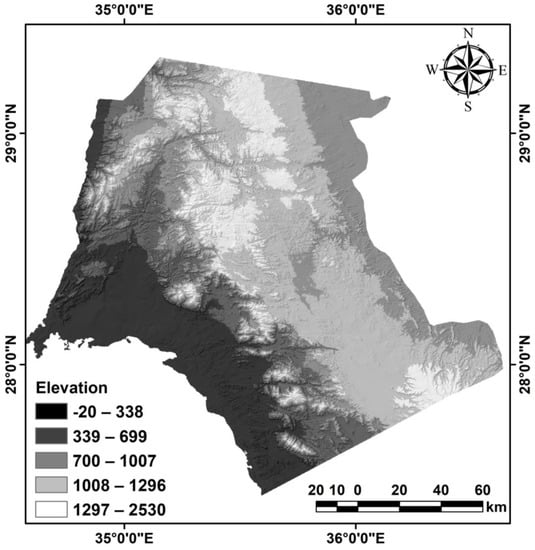
Figure 3.
Digital elevation model of the surface elevation in Neom, with a flat coastal plain ranging from −20 to 338 m AMSL in the west and the mountains in the central area rising to 2530 m AMSL.
2.4. Methodology
Remote sensing (RS) is a unique and commonly employed approach for acquiring spatiotemporal data for broad areas in a short time [18,19]. RS data, together with soil, land use, and precipitation records, were used in the present study to identify groundwater, flood, and drought potential zones in the Neom region. It is critical in hydrological investigations, particularly in remote areas where field data are scarce [20,21,22,23,24,25,26,27].
Several spatial image products and datasets were created and obtained. The topographic map, slope degree, and drainage density of the study region were extracted using a digital elevation model, which is a 3D representation of the Earth’s surface that is essential for mapping and assessing disaster risks [28].
Land cover maps of the Neom region were created using Environmental Systems Research Institute (ESRI) data, including a 10 m land cover map derived from 2020 Sentinel-2 imagery. The data, which are freely accessible via the ESRI portal (https://livingatlas.arcgis.com/landcover/, accessed on 14 May 2021), were the most recent land cover map available during the course of this study [29].
The Food and Agriculture Organization (FAO) offers soil maps of continents and significant regions throughout the world in the form of datasets of soil resources [30]. A soil map of Neom was created using FAO digital soil maps. In addition, precipitation data for the study site were obtained from the Saudi Arabian Ministry of Environment, Water, and Agriculture.
ArcGIS was utilized to construct all essential features and conduct the necessary analyses. A geodatabase was constructed to store the various spatial analytical datasets [31]. A dataset in raster format was also developed of the slope, stream density, and topography data. The majority of the imagery data were in raster format, whereas the precipitation, soil, and land-cover data were provided in vector file format. To complete the process, data in the vector format were transformed to a raster format and projected onto the Universal Transverse Mercator projection [32].
The weighted overlay tool in ArcGIS was used to assign weights to the created spatial datasets, depending on their significance for identifying groundwater, flood, and drought potential zones. The resulting maps featured four zones, namely, good, moderate, poor, and very poor areas. Eight thematic layers, including precipitation, geology, slope gradient, elevation, soil, lineament density, drainage density, and land cover, were used to assess the availability of possible zones of shallow groundwater, floods, and drought [33].
3. Results
The following sections describe the various datasets that were created for mapping the potential groundwater, flood, and drought zones. The use of multiple datasets was implemented to improve the quality of the results. The following factors were examined in this study: drainage density, lineament density, elevation, slope, land use, geology, precipitation, and soil characteristics.
3.1. Drainage Density
Drainage and drainage density affect the presence of groundwater in an area [34]. The amount of surface water runoff and infiltration into the shallow aquifers increases along with the drainage density. A region’s drainage is impacted by its terrain, slope, and subsurface. Figure 4 shows the drainage density determined by the GIS to better understand the region’s capacity to store groundwater. The land was divided into five categories based on the drainage density map: 0–0.77, 0.78–1.24, 1.25–1.68, 1.69–2.22, and 2.23–4.38 km2.
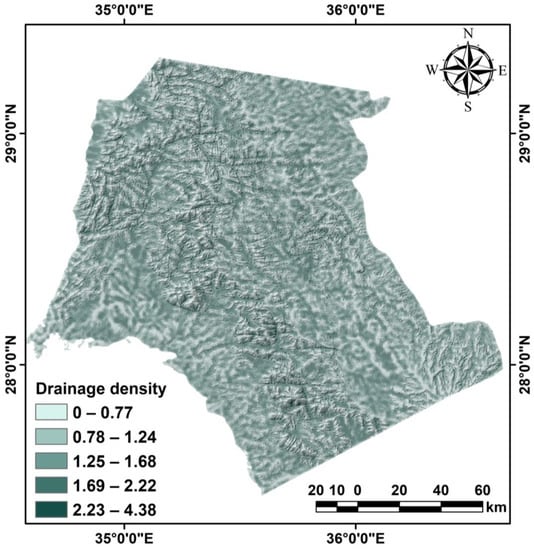
Figure 4.
Map showing that the Neom area has five classes based on the drainage density. The smallest class is 0–0.77, and the largest is 2.23–4.38 km2.
3.2. Lineament Density
Lineaments, which are the surface manifestations of subsurface fractures, represent the porosity and permeability of the underlying materials [35]. The main channels for groundwater flow and storage are joints and faults in impermeable rocks. This study used a geological map and satellite images to identify lineaments in the study area. Figure 5 depicts a map of the lineament density based on the line density method, demonstrating that the majority of the fractures were concentrated in the montane region. The map clearly shows that the region is divided into five categories: 0–0.05, 0.06–0.12, 0.13–0.2, 0.21–0.36, and 0.37–0.73 km2.
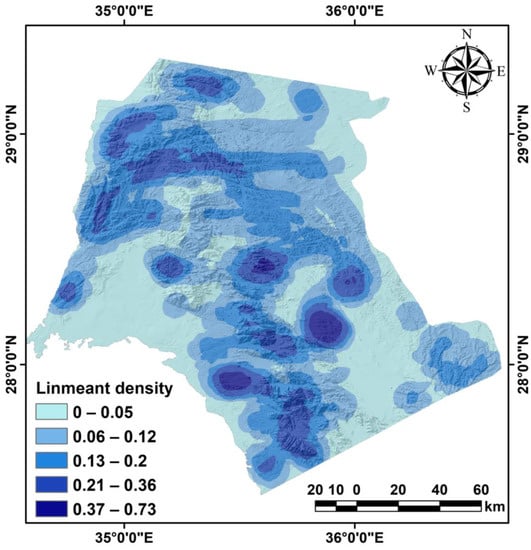
Figure 5.
Map of the lineament density in Neom consisting of five classes, ranging from 0.0–0.05 to 0.37–0.73 km2.
3.3. Elevation
The elevation of the research area ranged from a maximum of 2518 m AMSL to a minimum of −5 m AMSL (Figure 3). The ground surface normally sloped from the center of the study area’s mountains toward the Red Sea Shoreline in the west and the plain area in the east. The elevation of the study area was classified into five categories: −20 to 338, 339–699, 700–1007, 1008–1296, and 1297–2530 m AMSL.
3.4. Slope
The degree of the slope has a significant effect on the infiltration of surface water into the ground. Low-slope locations can retain rainwater and allow its percolation into the ground to recharge the shallow aquifers. Conversely, if the slope is steep, then the runoff flows more quickly, thus allowing less time for water to rest on the ground’s surface and significantly reducing the potential for groundwater recharge [36]. The slope depends on topographic characteristics, i.e., elevation. The slope of the study site varied from 0 to 70° (Figure 6), with most of the high slopes observed in the mountainous area, whereas the remaining areas in the east and west had slopes between 0 and 11°. Based on the slope, the study area was divided into five classes: 0–6°, 7–14°, 15–24°, 25–35°, and 36–78°.
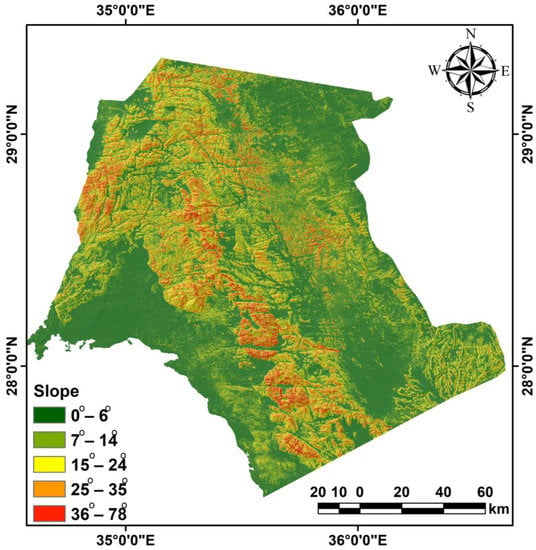
Figure 6.
Map showing that the slopes of the study area are steep in the mountainous region and flat to the east and west of the Neom area.
3.5. Land Use and Land Cover
A region’s land use/land cover (LU/LC) indicates its dependence on groundwater in terms of groundwater penetration [37], which regulates numerous hydrological processes, including evapotranspiration, runoff, and groundwater recharge. Residents of arid locations tend to permanently settle in areas with sufficient groundwater for drinking and irrigation. Figure 7 shows that the research area was mostly composed of three types of land: bare land, residential areas, and agricultural land.
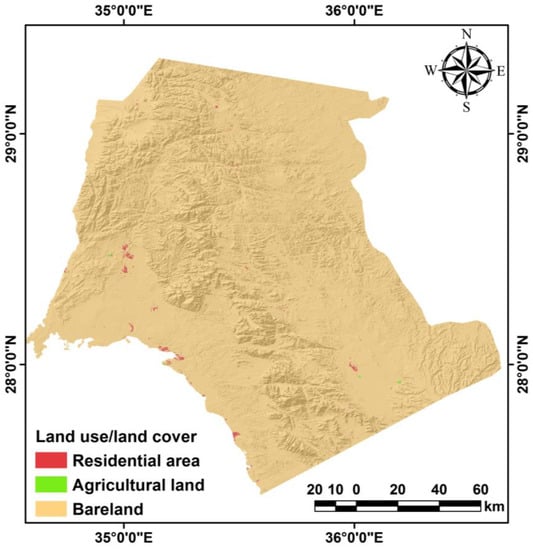
Figure 7.
Land use/land cover map showing that the Neom area is a typical desert area primarily made up of bare land. The residential and agricultural areas represent less than 1% of the total area.
3.6. Lithology
Geological maps can be used to investigate a region’s groundwater conditions; although, the geological units that affect the occurrence and flow of groundwater should be interpreted with caution [38]. The principal lithological units in the research region were Precambrian rocks, Tertiary rocks, and Quaternary deposits (Figure 2). Granite, granodiorite, rhyolite, diorite, gneiss, and schist were the Precambrian rocks detected in the study area. Because of their limited porosity, these rocks have a poor groundwater potential, as water can only penetrate through secondary porosity generated by fractures and weathering. The second units were Ordovician rocks (such as crystalline rocks), intensely fractured quartz, shale, fine sandstone, siltstone, massive quartz sandstone, and conglomeratic rocks with pebbles from the underlying Precambrian complex [39]. These types of rocks are more porous than Precambrian rocks. In addition, Neom has gypsum, sandstone, limestone, siltstone, conglomerate, and cross-bedded sandstone among the Tertiary rocks. Because of their moderate-to-high porosity, these rocks have a greater groundwater capacity than do Precambrian rocks. Finally, the Quaternary rocks consist of alluvial fans, terraced wadi alluvium, coralline limestone deposits, gravel, sand, and silt. These sediments and rocks possess the highest porosity and groundwater capacity.
3.7. Annual Precipitation
The climate of Saudi Arabia is defined as desert and dry [40] and is affected by location and season. The majority of the annual precipitation occurs during spring and winter. Between October and April, much of Saudi Arabia receives little to no precipitation in some years. Figure 8 depicts the annual average precipitation for the study region. The annual precipitation rate in the research region was divided into five categories: 51–74, 75–93, 94–107, 108–123, and 124–150 mm.
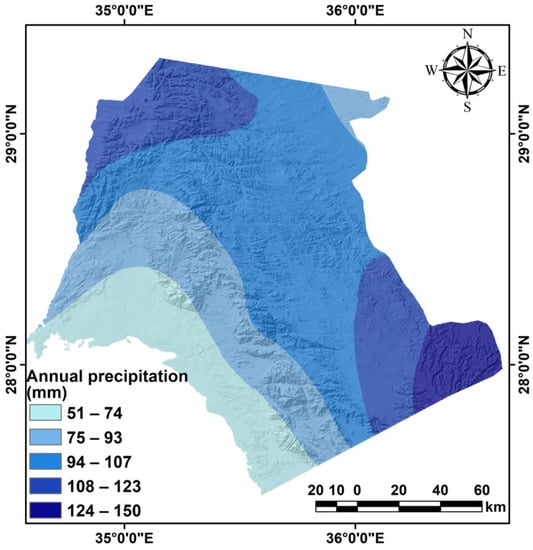
Figure 8.
Map presenting the annual precipitation average for the study region. The northwest and southwest regions of Neom receive the most precipitation.
3.8. Soil Type
Figure 9 shows the distribution of soil types in the study region, which were divided into three classes: clay, loam, and sandy loam. The majority of the clay and sandy loam soils were found in the eastern and southeastern regions of the research area. The loam soil type predominated in the remaining regions and along the shore of the Red Sea. The infiltration and percolation rates of water entering shallow aquifers are substantially affected by the soil type [41]. Loam and sandy loam soils are beneficial for groundwater recharge, as opposed to clay, which reduces surface water infiltration and percolation [42].
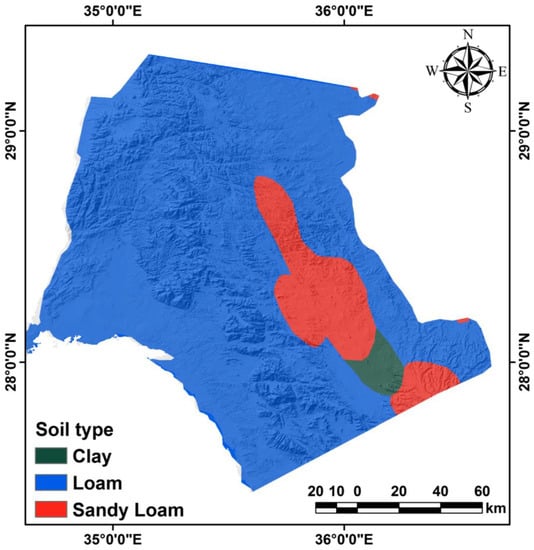
Figure 9.
Map of the distribution of the three soil types in Neom: clay, loam, and sandy loam. Clay and sandy loam were detected in the eastern and southeastern regions, whereas the remainder of the area had loam soil.
3.9. Determination of Groundwater, Flood, and Drought Zones
The potential groundwater, flood, and drought zones in the Neom region were determined based on RS data and GIS methodologies. For the overlay analysis, thematic layers were weighted and scaled into five classes. Thematic layers were used and evaluated based on their importance for finding the target zones.
3.9.1. Groundwater Potential Zoning
The following thematic layers were utilized to determine zones with groundwater potential: drainage density, lineament density, precipitation, elevation, lithology, slope, soil, and LULC. To prepare the layers for the overlay analysis calculations, they were first reclassified and scaled from 1 to 5, with 1 and 5 representing the least and most significant layers, respectively, for identifying groundwater. The drainage density and lithology were attributed greater weight than were lineament density and soil. Low-slope and low-elevation regions had significant groundwater potential. However, the groundwater potential was not affected by lineament; rather, groundwater was associated exclusively with geomorphological valleys and lowlands. Zones with a low groundwater potential were defined primarily by low-porosity rocks such as Precambrian rocks. The Groundwater zones were largely determined based on where people live and farm because people and farmers tend to move to areas with groundwater.
Table 1 provides a category-by-category breakdown of the eight thematic levels and their respective weights and ranks, which were used for the overlay analysis. The resulting groundwater potential zone map is depicted in Figure 10, which shows that the groundwater potential of the study area fell into four categories: very poor, poor, moderate, and good. The area with good groundwater potential covered 515 km2, whereas the areas with moderate, poor, and very poor groundwater potentials measured 11,562, 10,616, and 289 km2, respectively.

Table 1.
Showing the eight layers used in the overlay analysis to find potential groundwater zones and their influences, classes, and scales.
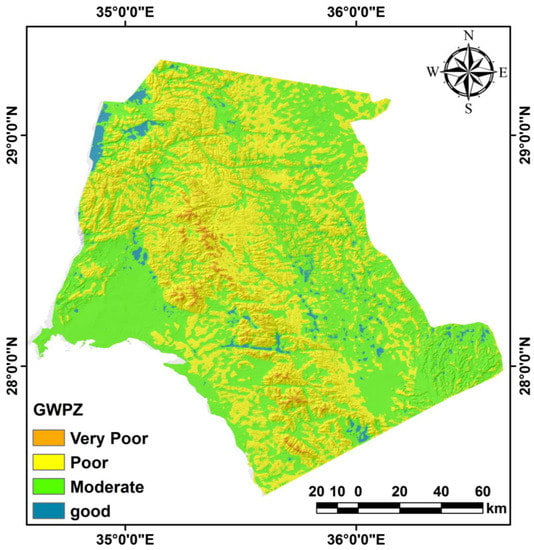
Figure 10.
Map displaying the potential groundwater zones in the Neom area. Approximately 515 km2 of land has good groundwater potential.
3.9.2. Flood Potential Zoning
The following thematic layers were used to identify flood-prone zones: drainage density, precipitation, elevation, slope, and soil. Prior to the overlay analysis, the layers were first categorized, weighted, and scored from 1 to 5. Greater weights were assigned to drainage density and elevation vs. precipitation and slope, whereas soil received the least weight. The low-slope and low-elevation locations were highly susceptible to flooding, whereas soil had little effect on the flood risk. Typically, floods occur in valleys and lowlands when heavy rainfall flows into regions with dense drainage systems. The probability of flooding is low in locations with a high elevation and a steep slope.
Table 2 breaks down the categories of the five thematic levels, together with their respective weights and ranks. Figure 11 shows the results of the overlay analysis after assigning weights and ranks to each attribute. The possibilities of flooding in the study area were classified as very low, low, moderate, and high risk. The area with a very low flooding risk covered 195 km2, whereas the areas with low, moderate, and high risks of flooding measured 4355, 13,542, and 4868 km2, respectively.

Table 2.
Showing the five layers used to identify the potential flood zones and their influences, classes, and scales.
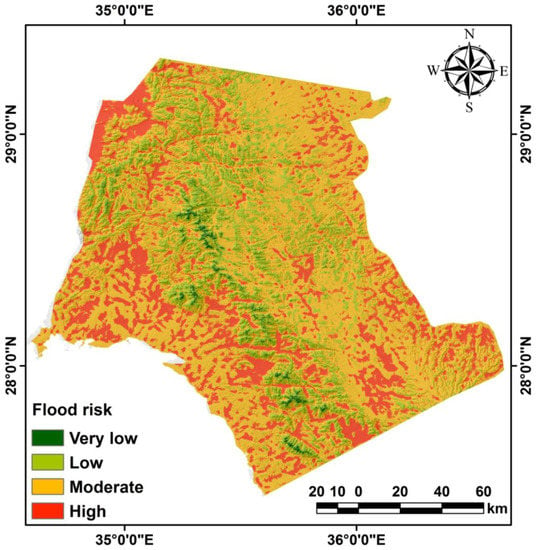
Figure 11.
Map showing the areas in Neom with a very low, low, moderate, and high risk of flooding.
3.9.3. Drought Potential Zoning
The drought-prone zones were determined by examining the drainage density, precipitation, and elevation data. The method used to prepare the data for the overlay analysis for the determination of potential groundwater and flooding zones was applied for the drought potential zoning. The drainage density and precipitation were attributed greater weight than elevation for the drought zoning. Drought is more likely to affect areas with poor drainage and little precipitation. Altitude has no impact on an area’s chances of drought, which can happen in both mountainous and lowland areas. Droughts are more likely to occur away from valleys and other areas that receive much rain.
Table 3 illustrates the significance of each of the five layers, whereas Figure 12 displays the results of the overlay analysis after assigning a priority and rating to each attribute. The likelihood of the occurrence of a drought in the Neom region was classified as very low, low, moderate, and high. The low-drought-risk area covered 4322 km2, whereas the areas with a very low, moderate, and high drought risk measured 43, 10,615, and 8266 km2, respectively.

Table 3.
Showing the layers used to predict the potential drought zones in Neom and the priority and rating of each layer.
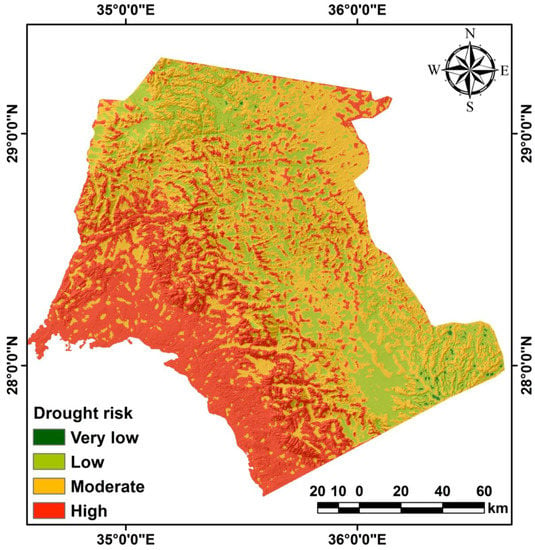
Figure 12.
Map showing the possibilities of drought in each area in Neom. Approximately 7978 km2 of the area exhibits a high drought risk.
4. Conclusions
The groundwater, flood, and drought potential zones of the Neom region were mapped to support efforts for planning sustainable groundwater exploitation and forecasting flood and drought hazards using an overlay analysis. This investigation revealed the zones with good, moderate, poor, and very poor potential of having groundwater cover in 515, 11,562, 10,616, and 289 km2 of Neom, respectively. A total of 4910 km2 of land had the highest flood danger, and the very low, low, and moderate risks covered 195, 4355, and 13,542 km2, respectively. A total of 8266 km2 of Neom land was classified as having high drought risk, and the other very low, low, and moderate classes were associated with 44, 4322, and 10,615 km2 of land, respectively.
Integrating remote sensing data with GIS tools can help identify locations with high groundwater potential, flood risk zones, and drought risk zones in arid lands and areas with limited field data. This knowledge will help decision makers plan and manage the future construction. Further work is required to illuminate the impact of flood, drought, and megacity construction on Neom’s groundwater quality.
Funding
This research was funded by the Deputyship for Research and Innovation, Ministry of Education, Saudi Arabia grant number IFKSURG-2-449.
Informed Consent Statement
Not applicable.
Data Availability Statement
All data generated or analyzed during this study are included in this published article.
Acknowledgments
The author extends their appreciation to the Deputyship for Research and Innovation, Ministry of Education, Saudi Arabia, for funding this research work through the project no. IFKSURG-2-449. In addition, the author thanks the anonymous reviewers for their careful review of the manuscript and their valuable suggestions and constructive comments.
Conflicts of Interest
The author declares no conflict of interest.
References
- Fallatah, K. Guide for Sustainable Design of NEOM City; Rochester Institute of Technology: Rochester, NY, USA, 2019; MSc; p. 73. [Google Scholar]
- Al-Sefry, S.A.; Şen, Z. Groundwater rise problem and risk evaluation in major cities of arid lands–Jedddah Case in Kingdom of Saudi Arabia. Water Resour. Manag. 2006, 20, 91–108. [Google Scholar] [CrossRef]
- El Waheidi, M.M.; Ghrefat, H.; Qaysi, S.; Batayneh, A.T.; Russo, G.; Jallouli, C.; Badhris, O.; Maeshi, T.; Elawadhi, E.A.; Bahkali, I. Hydrogeophysical characterization of the coastal aquifer system in the northeast Gulf of Aqaba (Saudi Arabia): An investigation in the context of groundwater resources management. J. Coast. Res. 2021, 37, 41–51. [Google Scholar] [CrossRef]
- Youssef, A.M.; Sefry, S.A.; Pradhan, B.; Alfadail, E.A. Analysis on causes of flash flood in Jeddah city (Kingdom of Saudi Arabia) of 2009 and 2011 using multi-sensor remote sensing data and GIS. Geom. Nat. Hazards Risk 2016, 7, 1018–1042. [Google Scholar] [CrossRef]
- Almazroui, M.; Islam, M.N. Coupled model intercomparison project database to calculate drought indices for Saudi Arabia: A preliminary assessment. Earth Syst. Environ. 2019, 3, 419–428. [Google Scholar] [CrossRef]
- Almazroui, M. Assessment of meteorological droughts over Saudi Arabia using surface rainfall observations during the period 1978–2017. Arab. J. Geosci. 2019, 12, 694. [Google Scholar] [CrossRef]
- Alarifi, S.S.; Abdelkareem, M.; Abdalla, F.; Alotaibi, M. Flash Flood Hazard Mapping Using Remote Sensing and GIS Techniques in Southwestern Saudi Arabia. Sustainability 2022, 14, 14145. [Google Scholar] [CrossRef]
- Akhtar, N.; Syakir Ishak, M.I.; Bhawani, S.A.; Umar, K. Various Natural and Anthropogenic Factors Responsible for Water Quality Degradation: A Review. Water 2021, 13, 2660. [Google Scholar] [CrossRef]
- Akhtar, N.; Ishak, M.I.S.; Ahmad, M.I.; Umar, K.; Md Yusuff, M.S.; Anees, M.T.; Qadir, A.; Ali Almanasir, Y.K. Modification of the Water Quality Index (WQI) Process for Simple Calculation Using the Multi-Criteria Decision-Making (MCDM) Method: A Review. Water 2021, 13, 905. [Google Scholar] [CrossRef]
- Chaudhari, R.V.; Lal, D.; Dutta, S.; Umrikar, B.; Halder, S. Weighted overlay analysis for delineation of groundwater potential zone: A case study of pirangut river basin. Int. J. Remote Sens. Geosci. 2018, 7, 2319, 3484. [Google Scholar]
- Cai, T.; Li, X.; Ding, X.; Wang, J.; Zhan, J. Flood risk assessment based on hydrodynamic model and fuzzy comprehensive evaluation with GIS technique. Int. J. Disaster Risk Reduc. 2019, 35, 101077. [Google Scholar] [CrossRef]
- Aziz, M.A.; Hossain, A.B.M.Z.; Moniruzzaman, M.; Ahmed, R.; Zahan, T.; Azim, S.; Qayum, M.A.; Al Mamun, M.A.; Kader, M.A.; Rahman, N.M.F. Mapping of agricultural drought in Bangladesh using geographic information system (GIS). Earth Syst. Environ. 2022, 6, 657–667. [Google Scholar] [CrossRef]
- Ahmad, N.; Khan, S.; Ehsan, M.; Rehman, F.U.; Al-Shuhail, A. Estimating the Total Volume of Running Water Bodies Using Geographic Information System (GIS): A Case Study of Peshawar Basin (Pakistan). Sustainability 2022, 14, 3754. [Google Scholar] [CrossRef]
- Tubbs, R.E.; Fouda, H.G.A.; Afifi, A.M.; Raterman, N.S.; Hughes, G.W.; Fadolalkarem, Y.K. Midyan Peninsula, northern Red Sea, Saudi Arabia: Seismic imaging and regional interpretation. GeoArabia 2014, 19, 165–184. [Google Scholar] [CrossRef]
- Kahal, A.Y. Geological assessment of the Neom megaproject area, Northwestern Saudi Arabia: An integrated approach. Arab. J. Geosci. 2020, 13, 345. [Google Scholar] [CrossRef]
- Rasul, N.M.A.; Stewart, I.C.F.; Nawab, Z.A. Introduction to the Red Sea: Its Origin, Structure, and Environment. In The Red Sea; Springer: Berlin/Heidelberg, Germany, 2015; pp. 1–28. [Google Scholar] [CrossRef]
- Nofal, R.; Abboud, I.A. Geomorphological evolution of marine heads on the eastern coast of Red Sea at Saudi Arabian region, using remote sensing techniques. Arab. J. Geosci. 2016, 9, 163. [Google Scholar] [CrossRef]
- Behling, R.; Roessner, S.; Golovko, D.; Kleinschmit, B. Derivation of long-term spatiotemporal landslide activity—A multi-sensor time series approach. Remote Sens. Environ. 2016, 186, 88–104. [Google Scholar] [CrossRef]
- Alharbi, T.; Sultan, M.; Sefry, S.; ElKadiri, R.; Ahmed, M.; Chase, R.; Milewski, A.; Abu Abdullah, M.; Emil, M.; Chounaird, K. An assessment of landslide susceptibility in the Faifa area, Saudi Arabia, using remote sensing and GIS techniques. Nat. Hazards Earth Syst. Sci. 2014, 14, 1553–1564. [Google Scholar] [CrossRef]
- Milewski, A.; Sultan, M.; Yan, E.; Becker, R.; Abdeldayem, A.; Soliman, F.; Gelil, K.A. A remote sensing solution for estimating runoff and recharge in arid environments. J. Hydrol. 2009, 373, 1–14. [Google Scholar] [CrossRef]
- Selvam, S.; Dar, F.A.; Magesh, N.S.; Singaraja, C.; Venkatramanan, S.; Chung, S.Y. Application of remote sensing and GIS for delineating groundwater recharge potential zones of Kovilpatti Municipality, Tamil Nadu using IF technique. Earth Sci. Inform. 2016, 9, 137–150. [Google Scholar] [CrossRef]
- Vanneschi, C.; Rindinella, A.; Salvini, R. Hazard assessment of rocky slopes: An integrated photogrammetry–GIS approach including fracture density and probability of failure data. Remote Sens. 2022, 14, 1438. [Google Scholar] [CrossRef]
- Allafta, H.; Opp, C.; Patra, S. Identification of groundwater potential zones using remote sensing and GIS techniques: A case study of the Shatt Al-Arab Basin. Remote Sens. 2020, 13, 112. [Google Scholar] [CrossRef]
- Nowreen, S.; Newton, I.H.; Zzaman, R.U.; Islam, A.K.M.S.; Islam, G.M.T.; Alam, M.S. Development of potential map for groundwater abstraction in the northwest region of Bangladesh using RS-GIS-based weighted overlay analysis and water-table-fluctuation technique. Environ. Monit. Assess. 2021, 193, 24. [Google Scholar] [CrossRef] [PubMed]
- Mukherjee, I.; Singh, U.K. Delineation of groundwater potential zones in a drought-prone semi-arid region of East India using GIS and analytical hierarchical process techniques. Catena 2020, 194, 104681. [Google Scholar] [CrossRef]
- Prasad, P.; Priyanka, M.L.; Sarath, R.; Naidu, B.R.; Ravi, T. Mapping Groundwater Potential Zone and Flood Risk Zone in the Visakhapatnam District, India. In IOP Conference Series: Earth and Environmental Science; IOP Publishing: Bristol, UK, 2022; p. 012056. [Google Scholar]
- Awanda, D.; Nurul, H.A.; Musfiroh, Z.; Dwi, N.D. Spatial analysis for potential water catchment areas using GIS: Weighted overlay technique. AWANDA. In IOP Conference Series: Earth and Environmental Science; IOP Publishing: Bristol, UK, 2017; p. 012054. [Google Scholar]
- Polidori, L.; El Hage, M. Digital elevation model quality assessment methods: A critical review. Remote Sens. 2020, 12, 3522. [Google Scholar] [CrossRef]
- Huan, V.D. Accuracy Assessment of Land Use Land Cover LULC. In IOP Conference Series: Earth and Environmental Science; ESRI data in Con Dao island, Ba Ria—Vung Tau province, Vietnam; IOP Publishing: Bristol, UK, 2020; Volume 2022, p. 012010. [Google Scholar]
- Fao.org. Soil Maps and Databases|FAO Soils Portal. Food and Agriculture Organization of the United Nations, n.d. Available online: https://www.fao.org/soils-portal/data-hub/soil-maps-and-databases/en/ (accessed on 19 November 2022).
- Matejicek, L. Spatial modelling of air pollution in urban areas with GIS: A case study on integrated database development. Adv. Geosci. 2005, 4, 63–68. [Google Scholar] [CrossRef]
- Abijith, D.; Saravanan, S.; Singh, L.; Jennifer, J.J.; Saranya, T.; Parthasarathy, K.S.S. GIS-based multi-criteria analysis for identification of potential groundwater recharge zones-a case study from Ponnaniyaru watershed, Tamil Nadu, India. HydroResearch 2020, 3, 1–14. [Google Scholar] [CrossRef]
- Mahalingam, B.; Vinay, M. Identification of ground water potential zones using GIS and Remote Sensing Techniques: A case study of Mysore taluk-Karnataka. Int. J. Geom. Geosci. 2015, 5, 393–403. [Google Scholar]
- Schilling, K.E.; Wolter, C.F.; Isenhart, T.M.; Schultz, R.C. Tile drainage density reduces groundwater travel times and compromises riparian buffer effec-tiveness. J. Environ. Qual. 2015, 44, 1754–1763. [Google Scholar] [CrossRef]
- Subba Rao, N.N. Groundwater potential index in a crystalline terrain using remote sensing data. Environ. Geol. 2006, 50, 1067–1076. [Google Scholar] [CrossRef]
- Morbidelli, R.; Corradini, C.; Saltalippi, C.; Flammini, A.; Dari, J.; Govindaraju, R.S. A new conceptual model for slope-infiltration. Water 2019, 11, 678. [Google Scholar] [CrossRef]
- Scanlon, B.R.; Reedy, R.C.; Stonestrom, D.A.; Prudic, D.E.; Dennehy, K.F. Impact of land use and land cover change on groundwater recharge and quality in the south-western US. Glob. Chang. Biol. 2005, 11, 1577–1593. [Google Scholar] [CrossRef]
- Ghosh, P.K.; Bandyopadhyay, S.; Jana, N.C. Mapping of groundwater potential zones in hard rock terrain using geoinformatics: A case of Kumari watershed in western part of West Bengal. Model. Earth Syst. Environ. 2016, 2, 1. [Google Scholar] [CrossRef]
- Bosworth, W. Geological evolution of the Red Sea: Historical background [Review], and synthesis. In The Red Sea; Springer: Berlin, Germany, 2015; pp. 45–78. [Google Scholar]
- Amin, A.A. The extent of desertification on Saudi Arabia. Environ. Geol. 2004, 46, 22–31. [Google Scholar] [CrossRef]
- Teegavarapu, R.S.V.; Chinatalapudi, S. Incorporating influences of shallow groundwater conditions in curve number-based runoff estimation methods. Water Resour. Manag. 2018, 32, 4313–4327. [Google Scholar] [CrossRef]
- Al-Shammari, M.M.A.; AL-Shamma’a, A.M.; Al Maliki, A.; Hussain, H.M.; Yaseen, Z.M.; Armanuos, A.M. Integrated water harvesting and aquifer recharge evaluation methodology based on remote sensing and geographical information system: Case study in Iraq. Nat. Resour. Res. 2021, 30, 2119–2143. [Google Scholar] [CrossRef]
Disclaimer/Publisher’s Note: The statements, opinions and data contained in all publications are solely those of the individual author(s) and contributor(s) and not of MDPI and/or the editor(s). MDPI and/or the editor(s) disclaim responsibility for any injury to people or property resulting from any ideas, methods, instructions or products referred to in the content. |
© 2023 by the author. Licensee MDPI, Basel, Switzerland. This article is an open access article distributed under the terms and conditions of the Creative Commons Attribution (CC BY) license (https://creativecommons.org/licenses/by/4.0/).